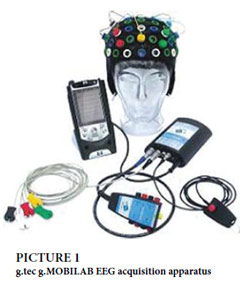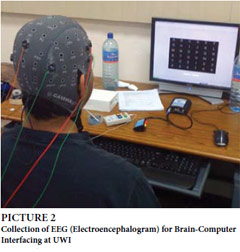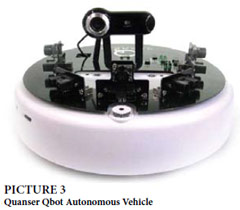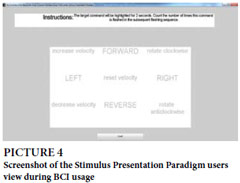
It is common for patients in the late stages of the neurodegenerative disease, Amyotrophic Lateral Sclerosis (ALS), to suffer a total loss of neuromuscular control that renders the individual incapable of using his/her limbs. When this happens, ALS patients can still perceive the world around them, but they are unable to move and communicate. They are said to be ‘locked in’ and their only recourse is to rely on an attendant for assistance in performing daily activities.
 However, Brain-Computer Interfaces (BCIs) can allow ‘locked in’ and similarly disabled individuals, such as quadriplegics and recovering accident victims, to communicate and interact with their environment, which reduces the need for an attendant and returns a measure of independence to the individual. However, Brain-Computer Interfaces (BCIs) can allow ‘locked in’ and similarly disabled individuals, such as quadriplegics and recovering accident victims, to communicate and interact with their environment, which reduces the need for an attendant and returns a measure of independence to the individual.
BCIs are a relatively new and exciting technology that allows individuals to control external devices using only their inherent brain activity. External devices in this regard can be virtual keyboards and wheelchair navigation systems, and using a BCI to control such systems creates a class of assistive technology for the disabled. The significant upside to BCIs is that they do not require the user to possess any pre-existing muscular control. The BCI system uses the patient’s brain waves to identify their instructions.
In January 2009, a BCI research laboratory was established within the Department of Mechanical and Manufacturing Engineering, Faculty of Engineering, at The UWI St. Augustine Campus. Collaborative research was undertaken with the University of Essex BCI Group which is a premier BCI group in the UK. The links with premier international research groups was instrumental in collecting brain data for analysis and obtaining training on a data acquisition system which was needed for research at UWI.
The UWI BCI uses Electroencephalography (EEG) to register the user’s brain activity. A range of other data collection methods can be used, but EEG is cheaper, more portable and requires less technical support for operation. EEG involves the collection of electric potentials at multiple points on the scalp. The measured electric potentials reflect the electrical correlate of brain activity. The EEG itself is a widely used tool in the clinical setting. It is commonly used for the diagnosis of mental conditions such as epilepsy and dementia.
 However, BCIs are not ‘one size fits all’. The BCI needs to be tuned to the user’s unique brain activity and this is done using dedicated subject training sessions. In general, these training sessions are time-consuming. In the context of BCI operation, lengthy subject training times are problematic because prolonged exposure to BCI Paradigms induces mental fatigue in BCI users, which degrades the quality of recorded brain data. The BCI research at UWI mainly focuses on the reduction of subject training times as well as the improvement of command identification accuracy. Misclassified subject commands are problematic since they either result in the execution of the wrong command or they require corrective action, which is very time-consuming and prohibits a wider use of the BCI approach for health, business and commercial applications. However, BCIs are not ‘one size fits all’. The BCI needs to be tuned to the user’s unique brain activity and this is done using dedicated subject training sessions. In general, these training sessions are time-consuming. In the context of BCI operation, lengthy subject training times are problematic because prolonged exposure to BCI Paradigms induces mental fatigue in BCI users, which degrades the quality of recorded brain data. The BCI research at UWI mainly focuses on the reduction of subject training times as well as the improvement of command identification accuracy. Misclassified subject commands are problematic since they either result in the execution of the wrong command or they require corrective action, which is very time-consuming and prohibits a wider use of the BCI approach for health, business and commercial applications.
Hitherto, the research has succeeded in addressing these two main issues. The research led to an average classification performance increase of 19.33% and a 67.5% reduction in subject training time. These subject training times are the lowest reported in the BCI literature. The UWI BCI research is therefore state-of-the-art with regard to subject training time requirements. These findings are significant as the obtained performance benefits are application insensitive. This means that they apply equally to BCIs used for mouse and keyboard control and for wheelchair navigation. They therefore impact significantly on the entire BCI field.
 The current focus of the research is to integrate an autonomous vehicle controller shown in the image below to the existing BCI. The BCI will be used to wirelessly drive the vehicular system using commands sent from the user. As vehicular control systems are scalable, the successful completion of this segment of the research will serve as a proof of concept for the control for larger vehicular systems such as wheelchairs using the UWI BCI. This application platform also spotlights the applicability of BCI technologies for the able-bodied in the form of novelty consumer electronic items such as BCI-driven remote-controlled vehicles. The current focus of the research is to integrate an autonomous vehicle controller shown in the image below to the existing BCI. The BCI will be used to wirelessly drive the vehicular system using commands sent from the user. As vehicular control systems are scalable, the successful completion of this segment of the research will serve as a proof of concept for the control for larger vehicular systems such as wheelchairs using the UWI BCI. This application platform also spotlights the applicability of BCI technologies for the able-bodied in the form of novelty consumer electronic items such as BCI-driven remote-controlled vehicles.
The UWI BCI utilises the P300 wave as a carrier of information to relay subject instructions. There are other brain signals that could be used for this, however the P300 is advantageous because it can be evoked with little subject training and minimal stress. The Stimulus Presentation Paradigm (SPP) that is used to evoke the P300 wave to relay user instruction in the UWI BCI is embodied in the screenshot below. This screenshot is used to explain how the P300 is used in conjunction with nine symbolic commands (the Speller Matrix) for an autonomous vehicle controller.
The SPP presents the user with a collection of nine symbolic commands. The subject is instructed to focus on a particular command and all nine commands are flashed in a random sequence. The P300 wave is elicited when the command at which the user is gazing is highlighted. The BCI inspects the post-stimulus segments of the EEG in order to identify the presence of the P300 waveform and therefore the subject command. The system therefore allows the user to select a command visually without the need for any significant mental and/or physical exertion.
 In the UWI BCI example, these commands are motive instructions sent by the user to an autonomous vehicle controller. However, the commands and target device can be changed to allow for BCI-based mouse control or virtual keyboard control. Additionally, since there are no limitations on the type of device that can be controlled by the BCI, the applicability of BCI technology is not limited to assistive and rehabilitative uses. Current research in the BCI field focuses on application areas that cater to the able-bodied population, such as virtual reality, gaming and home environmental control. In the UWI BCI example, these commands are motive instructions sent by the user to an autonomous vehicle controller. However, the commands and target device can be changed to allow for BCI-based mouse control or virtual keyboard control. Additionally, since there are no limitations on the type of device that can be controlled by the BCI, the applicability of BCI technology is not limited to assistive and rehabilitative uses. Current research in the BCI field focuses on application areas that cater to the able-bodied population, such as virtual reality, gaming and home environmental control.
For example, the NEILab group at Italy have managed to integrate the classic two-player competitive game ‘Pong’ to their BCI using EEG. Control signals are extracted from the recorded EEG and are translated into vertical paddle position that replaces the joystick input from the original game. Additionally, g.tec (Guger Medical Engineering, Austria) has developed a virtual reality research system that allows a user to navigate and select objects within a virtual environment using BCI. This technology could be tailored for the control of smart homes.
–BCI Research was established in the Department of Mechanical and Manufacturing Engineering, Faculty of Engineering, at the UWI St. Augustine Campus when Professor Chanan Syan joined the University in October 2006. The BCI research group comprises Professor Syan as the leader and Mr. Randy Harnarinesingh, a research assistant, with a number of part-time researchers.
|





